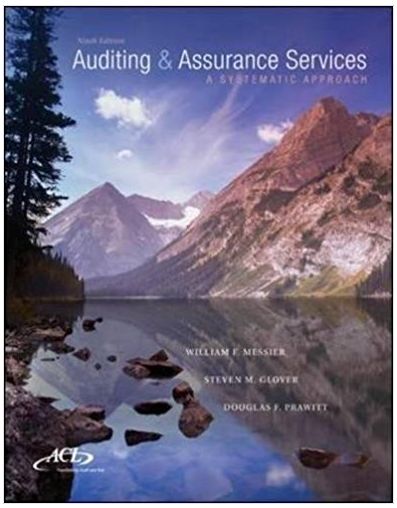Multiple Choice 1. Which of the following is not a part of the role of internal auditors?
Question:
Multiple Choice
1. Which of the following is not a part of the role of internal auditors?
a. Assisting the external auditors.
b. Providing reports on the reliability of financial statements to investors and creditors.
c. Consulting activities.
d. Operational audits.
2. Operational auditing is oriented primarily toward
a. Future improvements to accomplish the goals of management.
b. The accuracy of data reflected in management’s financial records.
c. Verification that an entity’s financial statements are fairly presented.
d. Past protection provided by existing internal control.
3. Which of the following would be considered an assurance service engagement?
I. Expressing an opinion about the reliability of an entity’s financial statements.
II. Reviewing and commenting on an entity- prepared business plan.
a. I only.
b. II only.
c. Both I and II.
d. Neither I nor II.
4. Which of the following best places the events of the last decade in proper sequence?
a. Sarbanes- Oxley Act, increased consulting services to auditees, Enron and other scandals, prohibition of most consulting work for auditees, establishment of PCAOB.
b. Increased consulting services to auditees, Sarbanes- Oxley Act, Enron and other scandals, prohibition of most consulting work for auditees, establishment of PCAOB.
c. Enron and other scandals, Sarbanes- Oxley Act, increased consulting ser-vices to auditees, prohibition of most consulting work for auditees, establishment of PCAOB.
d. Increased consulting services to auditees, Enron and other scandals, Sarbanes- Oxley Act, prohibition of most consulting work for auditees, establishment of PCAOB.
5. Which of the following statements best describes management’s and the external auditor’s respective levels of responsibility for a public company’s financial statements?
a. Management and the external auditor share equal responsibility for the fairness of the entity’s financial statements in accordance with GAAP.
b. Neither management nor the external auditor has significant responsibility for the fairness of the entity’s financial statements in accordance with GAAP.
c. Management has the primary responsibility to ensure that the company’s financial statements are prepared in accordance with GAAP, and the auditor provides reasonable assurance that the statements are free of material misstatement.
d. Management has the primary responsibility to ensure that the company’s financial statements are prepared in accordance with GAAP, and the auditor provides a guarantee that the statements are free of material misstatement.
6. Which of the following best describes the relationship between business objectives, strategies, processes, controls, and transactions?
a. To achieve its objectives, a business formulates strategies and implements processes, which are carried out through business transactions. The entity’s information and internal control systems must be designed to ensure that the transactions are properly executed, captured, and processed.
b. To achieve its strategies, a business formulates objectives and implements processes, which are carried out through the entity’s information and internal control systems. Transactions are conducted to ensure that the processes are properly executed, captured, and processed.
c. To achieve its objectives, a business formulates strategies to implement its transactions, which are carried out through business processes. The entity’s information and internal control systems must be designed to ensure that the processes are properly executed, captured, and processed.
d. To achieve its business processes, a business formulates objectives, which are carried out through the entity’s strategies. The entity’s information and internal control systems must be designed to ensure that the entity’s strategies are properly executed, captured, and processed.
7. The Public Company Accounting Oversight Board
a. Is a quasi- governmental organization that has legal authority to set auditing standards for audits of public companies.
b. Is a quasi- governmental organization that has legal authority to set accounting standards for public companies.
c. Is a quasi- governmental organization that has a policy to ignore public comment and input in the process of setting auditing standards.
d. Is a quasi- governmental organization that is independent of the SEC in setting auditing standards.
8. Which of the following is correct regarding the types of audits over which the ASB and the PCAOB, respectively, have standard- setting authority in the United States?
ASB ............... PCAOB
a. Nonpublic company audits ..... Nonpublic company audits
b. Public company audits ...... Public company audits
c. Nonpublic company audits .... Public company audits
d. Public company audits ...... Nonpublic company audits
9. Which of the following best describes the general character of the three generally accepted auditing standards classified as standards of field work?
a. The competence, independence, and professional care of persons per-forming the audit.
b. Criteria for the content of the auditor’s report on financial statements and related footnote disclosures.
c. Criteria for audit planning and evidence gathering.
d. The need to maintain an independence of mental attitude in all matters relating to the audit.
Financial StatementsFinancial statements are the standardized formats to present the financial information related to a business or an organization for its users. Financial statements contain the historical information as well as current period’s financial...
Step by Step Answer:

Auditing and Assurance Services A Systematic Approach
ISBN: 978-1259162343
9th edition
Authors: William Messier, Steven Glover, Douglas Prawitt





